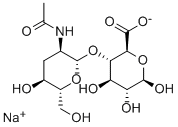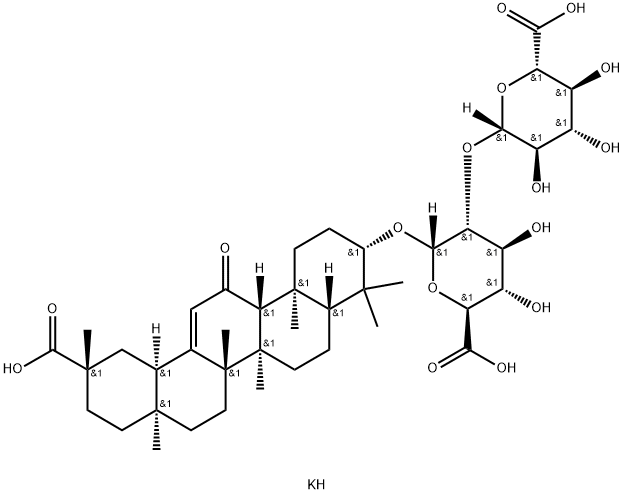Glycyrrhizicacid , 10mMinDMSO , 1405-86-3
Synonym(s):
3-O-(2-O-β-D -Glucopyranuronosyl-α-D -glucopyranuronosyl)-18β-glycyrrhetinic acid;GL;Glycyrrhetinic acid glycoside;Glycyrrhizic acid;Glycyrrhizinic acid
CAS NO.:1405-86-3
Empirical Formula: C42H62O16
Molecular Weight: 822.94
MDL number: MFCD00065194
EINECS: 215-785-7
| Pack Size | Price | Stock | Quantity |
| 1ml | RMB399.20 | In Stock |
|
| others | Enquire |
PRODUCT Properties
| Melting point: | 220°C (rough estimate) |
| Boiling point: | 681.01°C (rough estimate) |
| alpha | D17 +46.2° (c = 1.5 in alc) |
| Density | 1.1442 (rough estimate) |
| refractive index | 61 ° (C=1.5, EtOH) |
| storage temp. | under inert gas (nitrogen or Argon) at 2-8°C |
| solubility | DMSO (Slightly), Ethanol (Slightly), Methanol (Sparingly), Pyridine (Slightly) |
| form | Solid |
| pka | 2.76±0.70(Predicted) |
| color | White to Light Yellow |
| Odor | at 100.00 %. mild spicy |
| Odor Type | spicy |
| Merck | 14,4505 |
| Stability: | Hygroscopic |
| InChIKey | BXFBITNYMHAJGT-KYXJNIQISA-N |
| LogP | 4.64 |
| CAS DataBase Reference | 1405-86-3 |
| EPA Substance Registry System | Glycyrrhizin (1405-86-3) |
Description and Uses
Glycyrrhizin is a flavorant and foaming agent derived from the separation of flavonoids found in the whole licorice extract from the licorice root glycyrrhiza glabra. It is 50–100 times as sweet as sugar, is soluble in water, and has a licorice taste. It has good heat stability but prolonged heating can result in some degradation. It is stable within ph 4–9; below ph 4 there could be precipitation. It has foaming and emulsifying properties in water, being used in cocktail mixes and soft drinks. It is used as a flavorant in bacon and imitation whipped products. It is synergistic with sugar, the sweetness being amplified to 100 times that of cane sugar alone. It is used as a sweetener in sugar-free chewing gum and low-fat sugar-free frozen desserts. It is also termed ammoniated glycyrrhizin. Monoammonium glycyrrhizinate is obtained by additional refinement.
Safety
| Safety Statements | 22-24/25 |
| WGK Germany | 3 |
| RTECS | MD2025000 |
| HS Code | 29389090 |
| Hazardous Substances Data | 1405-86-3(Hazardous Substances Data) |
| Toxicity | human,TDLo,oral,5571ug/kg/3D- (5.571mg/kg),KIDNEY, URETER, AND BLADDER: OTHER CHANGES IN URINE COMPOSITION,Toxicologist. Vol. 54, Pg. 109, 2000. |




